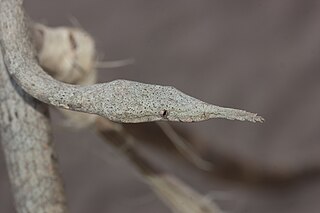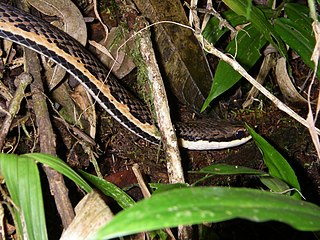
Boa is a genus of boas found in Mexico, the Caribbean, and Central and South America. Five extant species, and one extinct, are currently recognized.

The Typhlopidae are a family of blind snakes. They are found mostly in the tropical regions of Africa, Asia, the Americas, and all mainland Australia and various islands. The rostral scale overhangs the mouth to form a shovel-like burrowing structure. They live underground in burrows, and since they have no use for vision, their eyes are mostly vestigial. They have light-detecting black eye spots, and teeth occur in the upper jaw. Typhlopids do not have dislocatable lower jaw articulations restricting them to prey smaller than their oral aperture. The tail ends with a horn-like scale. Most of these species are oviparous. Currently, 18 genera are recognized containing over 200 species.

Grypotyphlops acutus, also known as the beaked worm snake, beaked blind snake, or beak-nosed worm snake, is a harmless blind snake species endemic to peninsular India. It is the only species in the genus Grypotyphlops. No subspecies are currently recognized.

Argyrophis diardii, commonly known as Diard's blind snake, the Indochinese blind snake, the large blind snake, or the large worm snake, is a species of harmless snake in the family Typhlopidae. The species is endemic to South Asia and Southeast Asia. There are two recognized subspecies.
Argyrophis oatesii, also known commonly as the Andaman Island worm snake or Oates's blind snake, is a species of harmless snake in the family Typhlopidae. The species is endemic to the Andaman Islands. There are no subspecies that are recognized as being valid.
Indotyphlops porrectus, the slender worm snake, is a species of harmless blind snake in the family Typhlopidae. The species is endemic to South Asia. There are no subspecies that are recognized as being valid. Not further Study available about this species. Because their number is almost non-existent and their picture has not been recorded yet۔

Leioheterodon is a genus of pseudoxyrhophiid snakes found only on the island of Madagascar. Three species are currently recognized. Common names include Malagasy hognose snakes, Malagasy brown snakes and Malagasy menarana snakes.

Sanzinia madagascariensis, also known as the Madagascar tree boa or Malagasy tree boa, is a boa species endemic to the island of Madagascar. It was once considered conspecific with the Nosy Komba ground boa. Like all other boas, it is non-venomous.

Acrantophis dumerili, commonly known as Dumeril's boa, is a species of non-venomous snake in the family Boidae. The species is endemic to Madagascar. No subspecies are currently recognized.

Acrantophis madagascariensis is a species of boid snake in the subfamily Sanziniinae that is endemic to the island of Madagascar. Its common names include the Madagascar ground boa and Malagasy ground boa.
Xenotyphlops is a genus of snakes, the only genus of the family Xenotyphlopidae, comprising two species found only in Madagascar. These snakes are also known as the Malagasy blind snake.
Mocquard's worm snake is a species of snake in the family Typhlopidae. The species is native to Africa.
Madatyphlops domerguei is a species of snake in the family Typhlopidae. The species is endemic to Madagascar.
Reuter's blind snake, also known commonly as Reuter's worm snake, is a species of snake in the family Typhlopidae.

Pararhadinaea is a monotypic genus of snakes in the family Pseudoxyrhophiidae. The only species is Pararhadinaea melanogaster, sometimes known as the Madagascar burrowing snake. It is endemic to the island of Madagascar.

Langaha is a small genus of elapoid snakes in the family Pseudoxyrhophiidae. The genus contains three species, all of which are endemic to Madagascar.

Liopholidophis is a genus of harmless snakes in the family Pseudoxyrhophiidae. The genus is endemic to the island of Madagascar.

Grandidier's Madagascar swift is a species of saxicolous lizard in the family Opluridae. The species is endemic to Madagascar.

Madatyphlops is a genus of snakes in the family Typhlopidae.

Flexiseps crenni is a species of skink, a lizard in the family Scincidae. The species is endemic to Madagascar.














